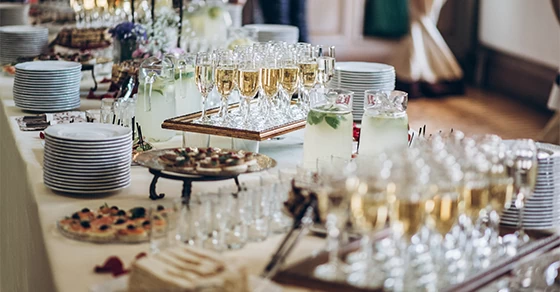Planning an event, whether it’s a wedding, corporate gathering, or casual get-together, involves numerous decisions. However, one of the most crucial choices you’ll make is selecting the perfect menu. Food is often the highlight of any event, and creating a menu that delights your guests can leave a lasting impression. Here’s a guide to help you choose the perfect menu for your next event.
1. Understand Your Guests’ Preferences
Before you start planning your menu, consider who your guests are. Are they adventurous eaters, or do they prefer classic dishes? Are there any dietary restrictions or allergies you need to accommodate? Understanding your audience is key to creating a menu that everyone will enjoy.
• Consider Dietary Restrictions: It’s important to offer options for guests with dietary restrictions, such as vegetarian, vegan, gluten-free, or nut-free dishes. Offering a variety of choices ensures that all your guests can enjoy the meal.
• Know the Crowd: If your event includes a diverse group of attendees, it might be wise to include a mix of familiar favourites and a few unique dishes for those who like to try something new.
2. Match the Menu to the Event Type
The type of event you’re hosting will greatly influence your menu choices. A formal black-tie event will require a different menu than a casual backyard barbecue.
• Formal Events: For weddings, galas, or corporate dinners, consider a multi-course meal that includes appetisers, a main course, and dessert. Elegant dishes like filet mignon, lobster, or a refined vegetarian option can be excellent choices.
• Casual Events: For more relaxed gatherings, you might opt for a buffet, food stations, or even a family-style meal. Dishes like grilled meats, salads, and comfort foods can be a hit.
• Theme-Based Events: If your event has a specific theme, like a Hawaiian luau or an Italian feast, tailor your menu to match the theme. This adds a cohesive element to the event and enhances the overall experience.
3. Consider the Season
Seasonality plays a significant role in menu planning. Using ingredients that are in season ensures that your dishes are fresh and flavourful.
• Spring and Summer: Lighter dishes with fresh vegetables, salads, and grilled proteins are ideal for warmer months. Consider options like citrus-marinated chicken, fresh seafood, or a variety of vibrant salads.
• Autumn and Winter: For cooler months, heartier dishes like roasted meats, root vegetables, and warm soups are perfect. Think about incorporating seasonal ingredients like butternut squash, cranberries, and mushrooms.
4. Balance the Menu
A well-balanced menu includes a variety of flavours, textures, and colours. Aim to offer a mix of dishes that complement each other, such as a rich main course paired with a light, refreshing side dish.
• Flavour Balance: Ensure there’s a mix of savoury, sweet, and tangy dishes to keep the palate interested throughout the meal.
• Texture Variety: Include dishes with different textures, such as crispy appetisers, creamy sides, and tender mains, to create a satisfying dining experience.
• Visual Appeal: Remember that we eat with our eyes first. A menu that includes a variety of colourful dishes will make your event not only delicious but also visually stunning.
5. Collaborate with a Catering Company
Choosing the perfect menu often involves working closely with catering companies. Experienced caterers can offer valuable insights and suggestions based on their expertise.
• Menu Customisation: A good catering company will work with you to create a menu that reflects your vision for the event. Whether you want a specific theme, cuisine, or a completely unique menu, caterers can help bring your ideas to life.
• Tastings: Most catering companies offer tasting sessions where you can sample dishes before making final decisions. This is an excellent opportunity to ensure that the flavours, presentation, and overall quality meet your expectations.
• Professional Guidance: Caterers can provide advice on portion sizes, service style (plated, buffet, stations), and timing to ensure that the meal flows smoothly and fits within the event schedule.
6. Don’t Forget the Beverages
Pairing the right beverages with your menu is essential for enhancing the dining experience. Whether it’s wine, cocktails, or non-alcoholic options, make sure your drink selection complements the food.
• Wine Pairings: Choose wines that enhance the flavours of your dishes. For example, a light white wine like Sauvignon Blanc pairs well with salads and seafood, while a bold red like Cabernet Sauvignon is perfect for richer meats.
• Cocktails: Signature cocktails can add a fun, personalised touch to your event. Consider creating a drink that matches the theme or colours of your event.
• Non-Alcoholic Options: Ensure there are plenty of non-alcoholic beverages available, such as sparkling water, juices, or mocktails, for guests who prefer not to drink alcohol.
7. Make it Memorable
The final touch to choosing the perfect menu is to add something unique that will make your event stand out. This could be a signature dish, a special dessert, or even a live cooking station where chefs prepare food in front of your guests.
• Interactive Food Stations: Live cooking stations, like a sushi bar or a pasta station, can add an interactive element to your event, making it more engaging for guests.
• Custom Desserts: A custom dessert, such as a cake that matches the event theme or a dessert bar with a variety of







